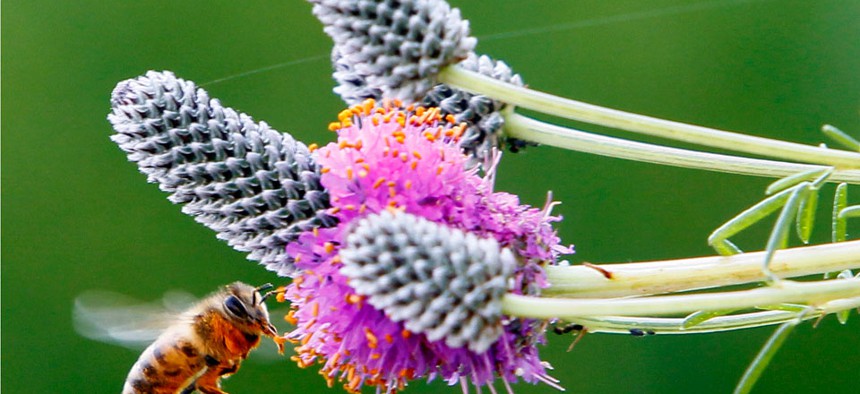The Internet of Bees Could Save Our Food Supply

Charles Rex Arbogast/AP File Photo
Scientists attach tiny sensors to 5,000 honey bees.
Australian scientists have devised a way to pinpoint the causes of the global die-off of bees that pollinate a third of the world’s crops: Attach tiny sensors to 5,000 honey bees, and follow where they fly.
The sensors, each measuring 2.5 millimeters by 2.5 millimeters (0.1 inch by 0.1 inch), contain radio frequency identification chips that broadcast each bee’s location in real-time. The data is beamed to a server, so scientists can construct a three-dimensional model of the swarm’s movements, identifying anomalies in their behavior.
Worker bees tend to follow predictable daily schedules—they don’t call them drones for nothing—leaving the beehive at certain times, foraging for pollen, and returning home along well-established routes. Variations in their routines may indicate a change in environment, such as exposure to pesticides.

Over the past decade, millions of bees have died as entire beehives have suddenly turned into tombs, a phenomenon known as Colony Collapse Disorder (CCD). Scientists have struggled to identify the causes of CCD. Some studies indicating that a class of agricultural pesticides called neonicotinoids are responsible for bee deaths. Others have pointed to everything from poor nutrition to stress to automotive exhaust .
But none of those studies have involved tracking bees’ behavior in real time in the real world. That’s where scientists at Australia’s Commonwealth Scientific and Industrial Research Organization (CSIRO) come in. If the sensor-equipped bees transmit data indicating that they have changed their behavior, say, by flying a circuitous path to and from the beehive, it may point to exposure to something in the environment, whether a pesticide or parasite. Researchers suspect that some pesticides may interfere with bees’ ability to orient themselves as they fly and forage. That’s crucial, as bees are social insects that communicate the location of pollen to other bees in the beehive.
If the bee sensors indicate that’s happening, scientists can immediately go to the bees’ location and investigate whether the crops and wildflowers in the area contain pesticides, and if so, how much. The 5,000 bees are being released in the Australian island state of Tasmania. “If we can model their movements, we’ll be able to recognize very quickly when their activity shows variation and identify the cause,” Paulo de Souza, the CSIRO scientists leading the swarm sensing effort, said in a statement.
So how do you attach a sensor to a bee?
Put them in a refrigerator. The cold induces a coma-like state long enough for the sensor to be attached to their backs with adhesive. The procedure takes a couple of minutes, and the bees then wake up and return to their hives. “The sensors appear to have no impact on the bee’s ability to fly and carry out its normal duties,” de Souza said.
The project will be watched closely in the rest of the world, particularly in Europe where a recent study found that demand for pollination is fast outstripping the supply of bees .
NEXT STORY: Issa, Connolly launch Cloud Caucus


